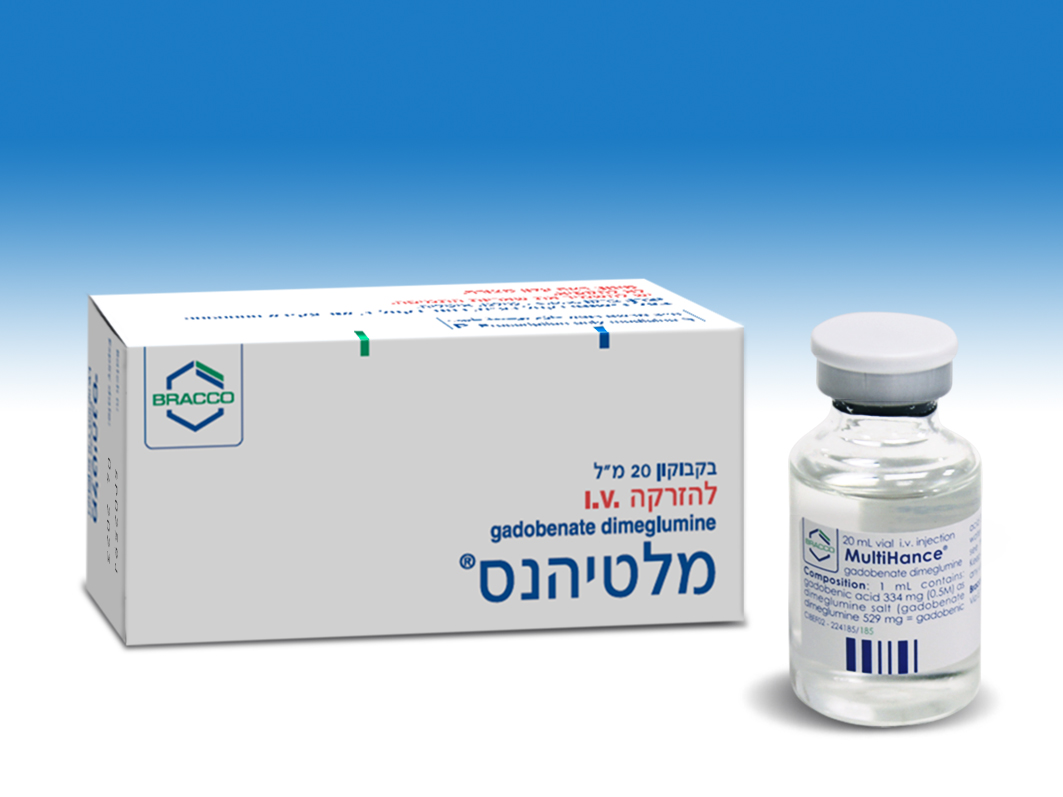Quest for the right Drug

מלטיהנס MULTIHANCE (GADOBENIC ACID AS DIMEGLUMINE SALT)
תרופה במרשם
תרופה בסל
נרקוטיקה
ציטוטוקסיקה
צורת מתן:
תוך-ורידי : I.V
צורת מינון:
תמיסה להזרקה : SOLUTION FOR INJECTION
עלון לרופא
מינוניםPosology התוויות
Indications תופעות לוואי
Adverse reactions התוויות נגד
Contraindications אינטראקציות
Interactions מינון יתר
Overdose הריון/הנקה
Pregnancy & Lactation אוכלוסיות מיוחדות
Special populations תכונות פרמקולוגיות
Pharmacological properties מידע רוקחי
Pharmaceutical particulars אזהרת שימוש
Special Warning עלון לרופא
Physicians Leaflet
Adverse reactions : תופעות לוואי
4.8 Undesirable effects The following adverse events were seen during the clinical development of MultiHance. System organ classes Clinical trials Post-marketing surveillance Common Uncommon Rare Frequency (≥1/100, <1/10) (≥1/1,000, <1/100) (≥1/10,000, <1/1,000) unknown** Immune system Anaphylactic Anaphylactic disorders /anaphylactoid reaction, shock Hypersensitivity reaction Nervous system Headache Paraesthesia, Convulsion, Syncope, Loss of disorders Hypoaesthesia, Tremor, Parosmia consciousness Dizziness, Taste perversion Eye disorders Visual disturbance Conjunctivitis Cardiac disorders Tachycardia, First- Myocardial ischaemia, Cardiac arrest, degree Bradycardia Cyanosis atrioventricular block Vascular disorders Hypertension, Hypotension, Flushing Respiratory, thoracic Dyspnoea, Respiratory and mediastinal Laryngospasm, failure, disorders Wheezing, Rhinitis, Laryngeal Cough oedema, Hypoxia, Bronchospasm, Pulmonary oedema Gastrointestinal Nausea Diarrhoea, Vomiting, Faecal incontinence, Oedema mouth disorders Abdominal pain Salivary hypersecretion, Dry mouth Skin & subcutaneous Pruritus, Rash Face oedema Angioedema tissue disorders including erythematous rash, macular, maculo- papular and papular rash, Urticaria, Sweating increased Musculoskeletal, Myalgia connective tissue and bone disorders Renal and urinary Proteinuria disorders General disorders and Injection Site Chest pain, Pyrexia, Asthenia, Malaise, Chills Injection site administration site Reaction Feeling hot. swelling conditions including injection site pain, inflammation, burning, warmth, coldness, discomfort, erythema, paraesthesia and pruritus. Investigations Electrocardiogram Blood albumin abnormalities*, decreased, Alkaline Blood bilirubin phosphatase increased increased, Blood iron increased, Increases in serum transaminases, gamma-glutamyl- transferase, lactic dehydrogenase and creatinine * Electrocardiogram abnormalities include electrocardiogram QT prolonged, electrocardiogram QT shortened, electrocardiogram T wave inversion, electrocardiogram PR prolongation, electrocardiogram QRS complex prolonged. ** Since the reactions were not observed during clinical trials with 4,956 subjects, best estimate is that their relative occurrence is rare (≥ 1/10,000 to <1/1000). The most appropriate MedDRA (version 16.1) term is used to describe a certain reaction and its symptoms and related conditions. Laboratory findings were mostly seen in patients with evidence of pre-existing impairment of hepatic function or pre-existing metabolic disease. The majority of these events were non-serious, transient and spontaneously resolved without residual effects. There was no evidence of any correlation with age, gender or dose administered. As with other gadolinium-chelates, there were reports of anaphylactic/ anaphylactoid/ hypersensitivity reactions. These reactions manifested with various degrees of severity up to anaphylactic shock and death, and involved one or more body system, mostly respiratory, cardiovascular, and/or mucocutaneous systems. In patients with history of convulsion, brain tumours or metastasis, or other cerebral disorders, convulsions have been reported after MultiHance administration (see section 4.4 Special warnings and precautions for use). Injection site reactions due to extravasation of the contrast medium leading to local pain or burning sensations, swelling, blistering and, in rare cases when localised swelling is severe, necrosis have been reported. Localised thrombophlebitis has also been rarely reported (see section 4.4 Special warnings and precautions for use). Isolated cases of nephrogenic systemic fibrosis (NSF) have been reported with MultiHance in patients co-administered other gadolinium-containing contrast agents (see Section 4.4). Paediatric population Adverse Reactions Clinical Trials System Organ Class Common Uncommon (≥1/100 to <1/10) (≥1/1000 to <1/100) Nervous system disorders Dizziness Eye disorders Eye pain, Eyelid oedema Vascular disorders Flushing Gastrointestinal disorders Vomiting Abdominal pain Skin and subcutaneous Rash, tissue disorders Sweating increased Adverse Reactions Clinical Trials System Organ Class Common Uncommon (≥1/100 to <1/10) (≥1/1000 to <1/100) General disorders and Chest pain, administration site Injection site pain, conditions Pyrexia The adverse reactions reported among paediatric patients treated with MultiHance during clinical trials and tabulated above were non-serious. The adverse reactions identified during post-marketing surveillance indicate that MultiHance safety profile is similar in children and adults. Reporting of suspected adverse reactions Reporting suspected adverse reactions after authorisation of the medicinal product is important. It allows continued monitoring of the benefit/risk balance of the medicinal product. Any suspected adverse events should be reported to the Ministry of Health according to the National Regulation by using an online form http://forms.gov.il/globaldata/getsequence/getsequence.aspx?formType=AdversEffectMedic@moh.go v.il

שימוש לפי פנקס קופ''ח כללית 1994
לא צוין
תאריך הכללה מקורי בסל
לא צוין
הגבלות
לא צוין
מידע נוסף
